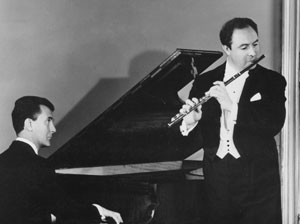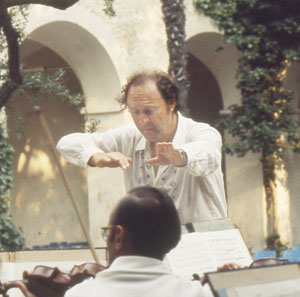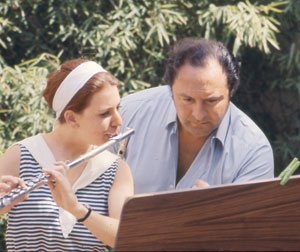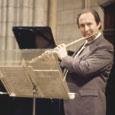The day, May 20, 2000, was beautiful, the air fresh, and the sky deep blue as my wife Judith and I drove over the Colorado Rocky Mountains toward Denver. We had spent the past few days visiting our daughter, who was living in Grand Junction, Colorado. We admired the breath-taking scenery while listening to Classical music on the radio when suddenly the music was interrupted by a news flash. “The music world has lost an icon. Flutist Jean-Pierre Rampal has died.” I was so stunned that I had trouble keeping the car on the road. Tears welled in my eyes; I had lost a dear friend of almost 50 years. As the reality of the news took hold, my mind drifted back to the 1950s and the first meeting that started a lifelong friendship. I share below some of our conversations collected over this time span.
Many people do not realize that Rampal might have become a relatively unknown physician, except for an incident that changed the direction of his life. Born in Marseilles, France, he studied with his father, Joseph Rampal, professor of flute at the Conservatory, but Jean-Pierre was not encouraged to become a flutist. As a third-year medical student, he was called up for military service during the German occupation of France in World War II. Learning that his outfit would be sent to Germany, Jean-Pierre made an unauthorized departure and went to Paris, where he felt a flute-playing medical student might be lost in a big city. A professor at the National Conservatoire in Paris persuaded him to attend classes; he left the Conservatory five months later with the first prize for flute playing. His career began to blossom with the liberation of France.
.jpg) I met Rampal for the first time following his U.S. premiere of the Poulenc Sonata at the Library of Congress in Washington, D.C., one of his first American performances. Over the ensuing years we saw each other many times and enjoyed numerous telephone conversations.
I met Rampal for the first time following his U.S. premiere of the Poulenc Sonata at the Library of Congress in Washington, D.C., one of his first American performances. Over the ensuing years we saw each other many times and enjoyed numerous telephone conversations.
On one occasion, Rampal called from a city an hour’s drive away. He said that he had no concert that night and asked if I would come and get him. I drove to his motel and found him pacing in the parking lot. After dinner and conversation, I returned him to his motel. The following day, he was to present a masterclass in Kalamazoo, Michigan, which Judith and I told him we would attend. The weather that morning was snowy, making the drive longer than expected. By the time we arrived, the session had just begun and all the seats were taken. We stood at the back of the hall. A person in the audience asked Rampal a question and after he replied, he asked, “Mark and Judith – why are you standing in the back of the hall?” As the entire audience turned to look, I told him all the seats were taken, whereupon he said, “You and Judith must come onto the stage and sit with me.” Once we were seated, he resumed the masterclass.
Rampal preferred flutes with low-C footjoints, suggesting that a shorter footjoint was better for Baroque music. He said that if anyone ever made a D footjoint, that would be even better. A year later, during one of my European tours, I had the opportunity to play trios with William Bennett and Alexander Murray, two of England’s premiere flutists. Bennett had a flute workshop in his house and I noticed a short, strange-looking footjoint that had been pieced together from spare flute parts. Bennett said it was his attempt at making a D footjoint. After some discussion, Bennett gave it to me. Happily, I put it in my suitcase and took it home. I called several New York City flute colleagues when I returned, and asked them to let Rampal know the next time they saw him that I now had a D footjoint for him. A week later, my telephone rang and Rampal asked, “Mark, what is this about the D foot joint?’ We enjoyed a good laugh over that for many years.
In 1978 I put together a number of questions about the flute and flute playing. He graciously consented to answer all of them.
Some call this era The Golden Age of the Flute. Why is it so popular?
I think it grew out of World War II. People needed balance in their lives, and Baroque music was ideal after a period that was so full of terrible things. Baroque music provided a certain quiet, and there are many Baroque chamber music works and concertos for flute and flute ensembles. For that reason both Baroque music and the flute became very popular.
There is also the fact that quite a bit of the Classical and Baroque literature published during the past 30-40 years is relatively easy to play. The flute seems easy to play at the beginning. By this I mean that players get results quickly when they first begin. Another reason may be the psychological effects for players because the flute helps express emotions.
At what age would you recommend starting the flute?.jpg)
I started at 13, but it depends upon when someone is ready. I could have been ready to play flute one or two years earlier. As a rule, I don’t think it helps to start at 9 or 10, as many youths will resist it, although some are ready before others.
Should prospective flutists have some basic music training before beginning on the instrument?
That is a good question. It is possible to start the flute without any musical background. I started that way. Afterwards, however, I did a lot of background study. It is not good to only be an instrumentalist, but you can start directly on the flute and why not? I really think it is better, however, to study solfeggio and harmony from the beginning.
What is your view on how long students should practice each day?
It depends upon how gifted they are. At the beginning, I think students should play very seriously for one hour every day – and this is not much. Those thinking of becoming professionals should aim for three or four hours a day, although there is not a limit.
So an hour a day is the minimum.
Yes. Practicing 10 minutes a day is nothing.
You prefer to teach in a class format rather than privately. What are the advantages of this approach?
Inspiration is the main advantage; you don’t get inspired yourself as a teacher with just one pupil. If the teacher is not inspired, neither is the pupil. It is like playing in a box – you get nothing from it. When you play in front of three or four people, there is an exchange. Both performer and listeners are inspired, and everyone gets better. Also, a class format creates the feeling of pleasant competition.
Do you still find it necessary to practice every day?
The problem for those who tour a lot, like you and me, is that we are obliged to go to our hotel room, close the door, and practice two hours a day. You fly quite a bit, meet people, and play concerts. You must drive yourself always, and it is very difficult to practice regularly while touring.
What should young players listen to when developing their tone?
Long tones. Start on low G (second line), play the octave, and then come back to the low G. Do this sequence in chromatic order, which will take about 10 minutes at least. Those who want to play well must do this, and they should play from the diaphragm – as when singing – not just blow. The tone study exercise books of Marcel Moyse are very good for tone development.

Your sound is glorious, yet your lip opening is off center. Do you recommend that for everyone?
No. My embouchure position is a mistake. My father did not play in the center, and I studied with him. Just because the opening is not in the center does not mean the lip opening is not “centered.” The main thing to listen for is a good tone and the projection of that sound.
Can you briefly describe a correct embouchure?
A correct embouchure is what you see in the Altes Method (Complete Method of the Flute) and the Gaubert Method.
How do you produce a rich and full tone in the low register?
Well, I don’t think it is more difficult to play the low register. When you blow just in front of the back wall of the embouchure plate, it is not so hard to project the sound. The airstream must be wider for low notes and smaller for high notes. I feel the sound in my lips when I play. I think that many players blow down into the flute too much for low notes and not enough at the back wall of the embouchure plate. This makes the tone very stuffy. There is no response to the sound.
Can you recommend some good daily basic warm-up exercises, such as scales and so on?
The daily finger exercise book by Taffanel & Gaubert is very good, as are the daily exercise books of Marcel Moyse.
What are some exercises for increasing breath control?
I never do any. Mine is just natural: I may be wrong, but I just open my mouth, breathe, and use my diaphragm. That is all that is necessary. The diaphragm is part of you. Since this is so, the breathing should be natural.
How do you feel about performing from memory?
I was not brought up to play from memory because it was not done then. Pianists and violinists in the conservatory do everything from memory because it is the custom, but wind instrument players rarely play from memory. I do not feel that it is necessary.
Oh, maybe sometimes I will play something from memory, such as the Mozart concertos, but I don’t feel that I play them any better without the music. I play them from memory because I feel more comfortable that way. Nothing is gained by playing from memory if you get distracted and forget where you are. Also, playing without music can create tension and lack of ease, which results in not playing well. If that is the case, use the music.

You play an open hole flute. Obviously you prefer this to the plateau (closed hole) model. Why is this?
Early flutes had just six holes before keys were added. Because of the mechanism today, there are still too many closed tone holes. The sound would be fantastic if it were possible to make a separate flute for each individual note, using only tone holes. The modern open-hole flute sounds much better than a closed-hole model. We should thank Louis Lot and Claire Godefroy for adding the open tone hole system, an improvement they accomplished without destroying the basic Boehm flute. It is a mistake to have all of the keys on the flute today, but we need them in order to play the different notes.
Your great finger technique is admired by many. What do you recommend for developing good technique?
I recommend lots of finger exercises, such as those found in various scales and exercise books. Practice intervals, such as minor thirds, and trills in two ways. For instance, play an F-E trill beginning on F. Then play the same trill, only this time start on E. In the former, your finger must pull down to the E, whereas in the latter your finger must lift to the F. It may sound ridiculous, but they are, in fact, two very different finger exercises. In other words, when trilling F to E, think only of the upper note (F). When trilling E to F, think only of the down note (E). You can do this with many trills. It looks the same but it is not.
The hand position should be good with relaxed, rounded fingers. Hands should never be tense. Let the right arm hang down in a relaxed manner. This is another reason why I recommend open hole flutes; the fingers must be placed precisely on the flute or the holes aren’t covered correctly. To me, closed hole flutes seem silly, because they allow a sloppy hand position and bad technique. Open hole flutes on the other hand, are much better because they require curved fingers and good hand position.
Do you advocate using alternate fingerings in certain passages?
Why not? However, always try to play the correct fingerings whenever possible. Much of today’s modern music calls for harmonic sounds and things like that where you use fake fingerings. However, you should use them only where necessary.
Many young flutists leave the left hand first finger down on middle D natural and E flat, as well as the right hand middle finger on F#. Do you agree that these fingerings should be avoided?
Of course – they are completely incorrect. A good flutist would never do this because they hear the tonal difference very easily.
Which B-flat fingering do you use most of the time and why?
I use the left hand double-thumb key. It is true B flat from a venting standpoint. The other B flats have various mechanical and specific uses. For chromatic scales, I use either the right hand first finger B flat or the B-flat lever right above it. For instance, in the slow movement of the Prokofieff Sonata, I slide from B flat to B natural with the left thumb. When I decide to use the right-hand B-flat trill lever, I call it A#, but it can be used as a B flat. It is best for players to be able to use all three B-flat fingerings.
Where does your tongue strike when making an attack?
Just between the teeth. Do not play between the lips-only between the teeth. You lose time by playing between the lips.
Do you feel the use of TA places the tongue too far back?
The syllable should sound like “Too,” which places the tongue very close to the opening between the teeth. “Ta” positions the tongue too far back in the mouth. Keep the lips smiling slightly, but not tense.
Far too many flutists play out of tune, especially in the high register, where they go sharp. What causes this?
When players go sharp, they are not angling the airstream in the proper direction, and air direction is the most important thing. In the high register, blowing the airstream directly across the embouchure hole causes sharpness. With the correct air angle and careful listening, however, you will not play out of tune. It is easy to play in tune. All good flutists play in tune. It is difficult to explain, but there is no excuse for playing out of tune.
What solo pieces should every young flutist learn?
All of the classic works. We don’t play enough of the Handel sonatas. They are nice in the beginning because they are not difficult and they teach phrasing so well. All young flutists should also learn the Bach sonatas, most of the Vivaldi concertos, and the Mozart concertos before they go on to contemporary works. I don’t mean to say that contemporary works are more difficult. In fact, I think that Mozart concertos are more difficult to play, because you can’t fake in Mozart.
How do you instruct someone to produce vibrato on the flute?
Vibrato should be natural, so it is difficult to speak about it. When vibrato has to be practiced it is unnatural. The body is completely involved in producing vibrato. When you speak, you have the vibrato – the vibrations.

You mean the human voice or singing vibrato, like the sound of a fine singer?
Yes, I think teachers should encourage beginning flutists to play like they speak. Sing some notes and then play them the same way. It is not so different to play like you speak.
How should students learn Baroque ornamentation?
There are many good books available. The Art of Ornamentation by Hans Peter Schmitt, (Barenreiter) is a beautiful book. Perhaps the best one to have is The Art of Playing the Transverse Flute by J.J. Quantz, published in 1752 in French. There is a second version in German, but there is no French version of it. There are many examples of ornamentation in this book. In every sonata, Quantz gave an indication of ornamentation.
Another book a student can buy is Twelve Sonatas by Telemann (Barenreiter). The first movement of every sonata includes a flute part and a proposed ornamentation written by Telemann himself of that flute part in the line above. However, that ornamentation is only a suggestion. Yesterday I played one of the Telemann sonatas and played my own ornamentation rather than the one that was printed. I felt it differently. Young players should play lots of pieces like this and become used to ornamentation by doing it. Other good music would be arias and other piano and harpsichord music.
You perform on solid gold flutes. Why do you prefer them to silver?
The sound of gold is darker, richer, and has more resonance, a fact that relates to its density. I think it is good for those with a bright, brilliant sound on silver to use a gold flute. I tried platinum once, but I did not like it. The flute was very heavy, and the tone very cold. But the gold for me is warm – it is beautiful! As for people without a good tone, I suggest that they play anything but the flute!
Do you ever become nervous? What advice can you offer for those who do?
Of course I get nervous. It is impossible not to. For instance, sometimes I play a concert in a small city for a small audience, but for some reason I get nervous. Other times, when I am in a big city before a large audience, I am not nervous. It is very strange, and I cannot explain it.
What is available, besides orchestral playing, for a flutist thinking of playing the flute for a career?
There are many more things available now for young professionals, such as being an artist-in-residence at universities and conservatories. Many schools have professional woodwind quintets and Baroque ensembles. Solo careers are also a possibility but it takes a long time and luck to build a reputation. You have to make recordings and then be lucky enough to find someone who is interested in your recordings–and they must be very popular. You have to have promotion and be able to sell yourself. I know of many young players who have talent and a manager and yet go nowhere. They blame their managers for their failures when, really, they don’t have that all important gift of being able to sell themselves. It is a lack of charisma. Many good players fail because they lack this important factor of
personality.
Many things have changed since my interview with Rampal, but his many pearls of wisdom about practicing, tone production, ornamentation, and stage fright are are just as applicable today as they were 35 years ago.
Jean-Pierre Rampal was a warm, outgoing man who enjoyed life to the fullest. He remains one of the most recorded artists in history; he traveled and performed until his death. He will continue to be sorely missed.






